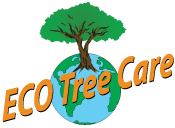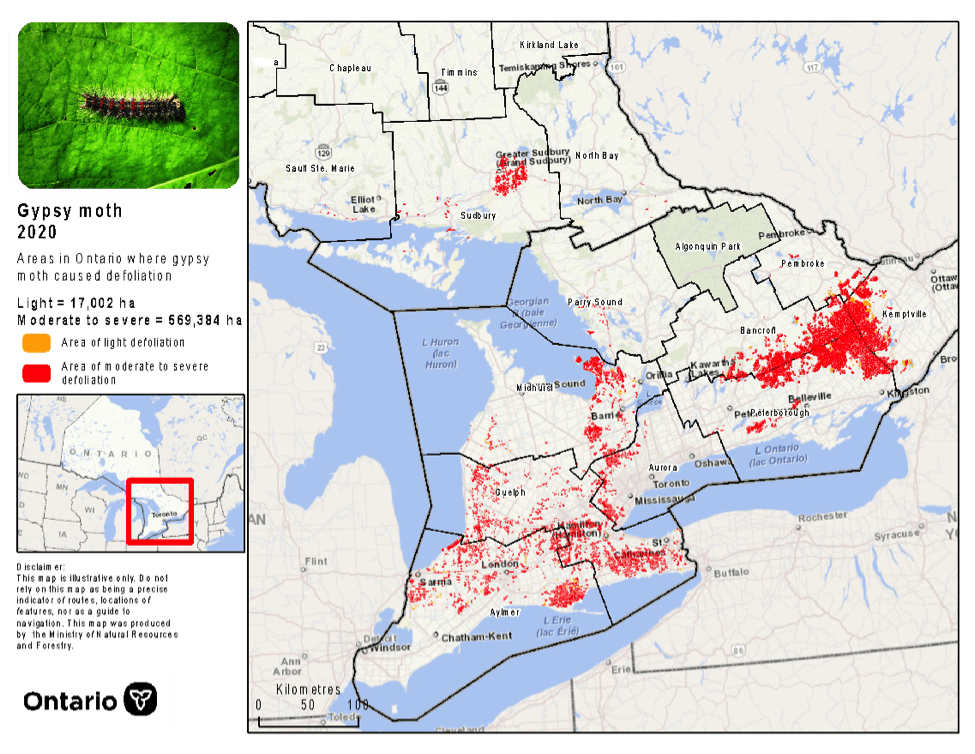Maintaining the overall health of trees and shrubs depends on a wide variety of factors, from soil conditions and light availability to insect impacts or disease susceptibility. Our Plant Health Care Technician will assess your trees or bushes on your property to determine how best to improve their condition. Some plant health care strategies that may be required include mulching, tree nutrition or fertilization, soil improvements, and/or disease and insect treatments. Eco Tree Care also offers a comprehensive Plant Health Care Program to ensure your trees are being assessed, monitored and treated over time for optimal health.
Mulching
Mulching involves forming a protective layer of loose organic matter (most often wood chips) around the trunk of a tree to maintain moisture levels and improve soil conditions.
Mulching is one of the most beneficial and low-cost practices that a homeowner can do for better tree health. Not only can mulching reduce soil moisture loss through evaporation, but it can.
- Minimize weed germination and growth
- Insulate soil and root temperatures from extreme heat and cold
- Improve soil biology and fertility as the mulch decomposes
- Promote soil structure, aeration, and drainage over time
- Inhibit certain plant diseases
- Reduce the risk of tree damage from lawn care equipment like mowers and weed whackers
- Improve the aesthetics of your landscape with a well-cared-for appearance
Eco Tree Care is happy to provide mulching services for you, but if you choose to mulch trees yourself, please follow these excellent guidelines provided by Trees Are Good and the International Society of Arboriculture:
Proper Mulching Techniques.
If you have a pile of brush, twigs, leaf litter, and/or limbs on your property, ask us about our chipping services to create your own mulch.
Tree Nutrition and Maintenance
In a landscaped environment, it’s common for landowners to remove unwanted organic matter from the ground. Leaves, protruding roots, broken twigs, seed pods, and other dead or alive plant life are often expected to be removed from lawns – especially front lawns – within the city. The unwanted consequence of removing this organic matter is the loss of nutritious elements re-entering the soil system, which impacts the nutrient availability for use by existing or new vegetation.
When nutrient levels are depleted or not regenerating at a rate required by trees and shrubs for optimal growth and vitality, fertilizing may be required. At Eco Tree Care, we offer several forms of fertilization to ensure your tree is accessing the nutrients and elements it needs.
Types of fertilizer may include:
- Organic/Inorganic: Organic fertilizers contain the element carbon, while inorganic fertilizers do not.
- Dry/Liquid: dry fertilizers are often granular in form, while liquid fertilizers contain nutrients and elements suspended or dissolved in a liquid medium.
Types of fertilizer application includes:
- Broadcast (soil surface application)
- Subsurface (deep root injection; drilled holes with granular fertilizer)
- Trunk Injection
- Foliar (sprayed onto leaves)
Soil Improvement
Fertilizer isn’t the only thing that can improve nutrient uptake by root systems, and in fact, for most cases, it isn’t the top recommendation when it comes to improving soil conditions. A tree or shrub can greatly benefit from other soil improvement techniques such as aeration or mulching.
Aeration and soil de-compaction is a technique of improving soil conditions that is often overlooked. Heavy foot traffic, construction supplies or equipment, or vehicle use near trees can impact the critical root zone of a tree by compacting the soil around the roots, effectively suffocating it. This soil compaction and root suffocation can lead to declining health of a tree, and even death.
By using aeration tools under the canopy of a tree, we can de-compact the soil and re-introduce efficient water and air flow, organic matter, and nutrient availability to the roots.
Disease and Insect Treatment
Trees can exhibit evidence of disease or insect infestation in a variety of ways, from leaf discolouration, malformations, or early dropping, to holes in bark or large growths on branches. If you suspect a disease or insect problem, give us a call as soon as you notice it. Treatment may be able to save a tree from severe damage, and even death and tree removal.
You may have heard about the Emerald Ash Borer, which has been widely spread throughout our region. Many municipalities have had to remove hundreds and thousands of ash trees in an effort to slow the spread of this invasive pest. Some ash trees have yet to be affected and can benefit from a preventative treatment with a biochemical compound called TreeAzin (manufactured and distributed by BioForest). Others have unfortunately succumbed to the borer’s devastating effects and have been removed or are scheduled for removal in the next couple years.
We would be happy to visit your property and complete an assessment of your tree to determine what kind of disease or insect may be impacting its health. Depending on the severity of the impact, we may recommend treatment or removal of the tree.
In Ontario, the application of pesticides should only be completed by a licensed pesticide applicator. Eco Tree Care has a Pesticide Exterminator License from the Ministry of Environment and Climate Change, which authorizes us to procure and apply pesticides commercially.
Eco Tree Care's Health Care Program
In addition to providing one-time plant health care services as described above, we also offer a comprehensive plant health care program that is tailor made to suit the needs of your property. This program includes: site evaluations, monitoring, and work agendas that take into account changing landscapes over time. Proper care and nourishment of your trees will be completed to our high standards to ensure both health and longevity.
Gypsy Moth Information
Gypsy Moth Infestation
The gypsy moth is an invasive insect from Europe that was accidentally introduced in North America in the 1860s during an attempt to rear an alternative silk-producing insect. Gypsy moth caterpillars are 5 to 60 millimetres in length, dark and hairy, with five pairs of blue dots and six pairs of red dots on the back. They feed on a wide range of hardwood trees, as well as evergreen trees, but show a preference to oak trees (Quercus), birch (Betula) and aspen (Populus) in the north, to various hardwoods such as sugar maple (Acer saccharum) American beech (Fagus grandifolia) and softwoods such as eastern white pine (Pinus strobus), balsam fir (Abies) and Colorado blue spruce (Picea pungens) in Southern Ontario.
Eastern Ontario is experiencing a higher than normal level of European Gypsy Moth infestations. The first detection of gypsy moth in Ontario occurred in 1969; however, widespread defoliation did not occur until 1981. It is reported that the Peterborough District had the largest area of moderate to severe defoliation of 159,578 hectares in 2020, an increase from 409 hectares in 2019. This concentrated area of defoliation extended to Kemptville District and north to the Pembroke District (see map)
Map Source:
https://www.ontario.ca/page/gypsy-moth
Characteristics and life cycle
● Overwinters in the egg stage often on the bark of trees.
● In spring, eggs hatch and larvae ascend the trees to feed on the new foliage.
● Initially, feeding occurs during the day, but as the caterpillars mature feeding occurs mainly at night — often this can delay the detection of infestations.
● Mature larvae are 50 mm long, dark coloured, hairy, with a double row of five pairs blue spots, followed by a double row of six pairs red spots, down the back.
● Feeding is completed in July.
● Male moths are light brown and slender-bodied, while females are white and heavy-bodied.


